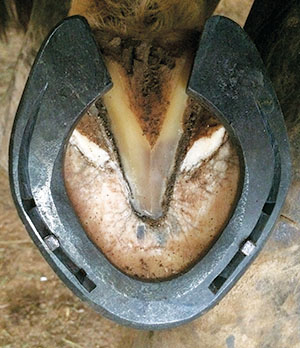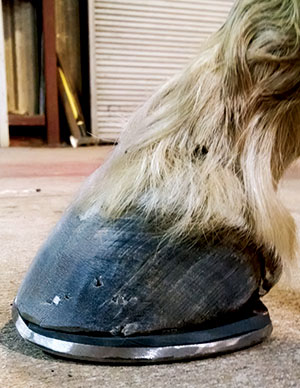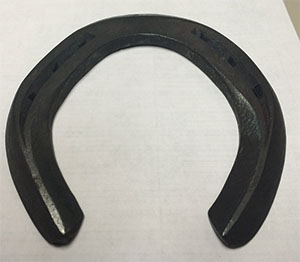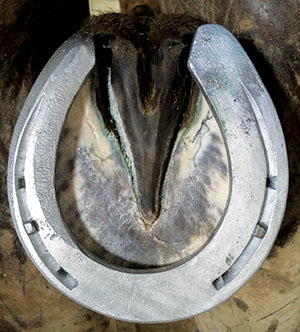The structures of the hoof capsule are the primary focus of a farrier’s job. Yet, there are other elements outside of the hoof capsule a farrier might have a role in supporting. Among them are soft tissue injuries.
Although there are a number of soft tissue injuries that performance horses might sustain, there are four that farriers most commonly face — injuries to the deep digital flexor tendon (DDFT), superficial digital flexor tendon (SDFT), suspensory ligament (SL) and collateral ligaments of the distal interphalangeal joint (CLDIP joint). When confronted with these injuries, a farrier might have a role at any stage from identification to rehabilitation.
Identifying Soft Tissue Injuries
The first indication of a soft tissue injury varies depending on the severity, but horses often will give subtle hints that something isn’t quite right.
“A horse that is uncomfortable on a limb will not bear as much weight on it,” says Eric Gilleland, a Social Circle, Ga., farrier. “This will result in the hoof being narrower. A horse might prefer one limb over the other, just as we might prefer our right hand to our left. Or, a horse that immediately shifts its weight off the opposite limb after the farrier puts down a foot also can be an indication.”
Although a horse might favor one limb, it’s important to examine the horse completely.
“Just because a horse is limping a certain way doesn’t mean that it’s always a specific problem,” says Dave Dawson, an Uxbridge, Ontario, farrier. “I don’t go into any case with a closed mind. I’m totally wide open.”
Anytime a lameness is apparent, a veterinarian should be contacted.
“There must be a team approach from beginning to end,” Gilleland says. “If a problem can be foreseen, the knowledge needs to be shared. When a problem arises, there should be open discussion between the vet and farrier immediately.”
The team approach involves the owner, barn manager, grooms, the farrier and the vet.

An onion shoe can help a horse with an ongoing, chronic injury to the deep digital flexor tendon. The wide heels help keep the heels higher than the toe, thus relaxing the tendon.
“You must have good grooms and barn managers who are going to follow the rehab protocol,” says Travis Burns, lecturer and chief of farrier services at the Virginia-Maryland College of Veterinary Medicine at Virginia Tech University in Blacksburg, Va. “You must have a farrier who can make or modify shoes to the degree that would match whatever injury there is. You must have a good vet who understands the injury and can treat it. If any of those three fall apart, then the horse is in trouble.”
Dawson is firm in his belief that farriers should stick to the hoof capsule and defer all else to a veterinarian.
“I come from the school where I really, strongly feel the farrier’s job is the hoof capsule,” Dawson says. “When we start getting into soft tissue, we need to work together as a team with a veterinarian. There are certainly a lot of farriers who know exactly what to do, but I really feel we should be consulting and working together.”
Deep Digital Flexor Tendon
As the DDFT courses distally to its insertion on P3, it is bound down by the distal anular phalanx, according to Adams’ Lameness In Horses, edited by Ted S. Stashak. The tendon passes over the complementary fibrocartilage (middle scutum), then has two secondary attachments to the distal aspect of the palmar surface of the bone. Continuing distad (toward the periphery in a distal direction) toward its primary attachment on the flexor surface of P3, the DDFT passes over the navicular bursa and is cushioned as its direction is changed.
There are a number of farrier-related options to treat a DDFT injury and the aim of each is to reduce tension on the only tendon that attaches to the coffin bone. By raising the palmar angle of the coffin bone, it reduces tension on the DDFT and the navicular apparatus, Burns says.
“It all depends on what kind of injury it is and how serious it is,” he says. “If the horse is on stall rest, then they are typically trimmed and shod with a wedge pad to elevate the palmar angle to try to reduce tension. In the rehab phase, they’re typically shod with some sort of device to increase surface area in the palmar/plantar portion of the hoof/shoe. It can be a shoe with onion heels, a bar shoe, or a shoe with a heel plate, etc. There are many different options to achieve the same principles.

A wedge pad and a rocker toe can benefit a horse that has an injury to the deep digital flexor tendon. The pad relaxes the tendon, while the rocker toe assists breakover.
“When the horse is in soft footing, the shoe would encourage the heel to float or sink less in the footing than the toe, therefore, creating a dynamic wedge. The amount of surface area used to encourage flotation (less sinking) should match the severity of the injury.”
It’s important to provide arch support when raising the heels, Gilleland says.
“If arch support is not provided, the foot will sink to some extent, depending on the integrity of the hoof wall,” says the partner of Bent Tree Forge. “An arch support can be obtained by using a full wedge pad, Vettec’s Equi-Pak, a properly applied heart bar or other similar methods. A rocker toe or rolled toe to assist in breakover can be useful while the horse is healing.
“Once completely healed, utilize the toe to its fullest extent to provide for the horizontal and vertical propulsion needed to move the horse in a forward motion.”
While most injuries have a well-known treatment protocol, Dawson suggests keeping an open mind and treating the specific case that’s in front of you.
“We often say, ‘OK, this works, so I’m going to do it on everything,’” he says. “We can’t do that because every horse isn’t the same. They’re all different. So you have to analyze each individual horse and why they have the injury and how they got there.”
Discovering how the horse arrived at the problem in the first place is not necessarily easy.
“So often the farrier is blamed for the deep digital flexor injury, but was it really the farrier who caused it?” Dawson asks. “We’re dealing with Mother Nature here. When you make Mother Nature angry, you’ll pay a big price. Is the animal predisposed to injuries? There are so many predisposing factors to injuries and horses.
“I’ve seen more injuries that have to do with environment and care management, as opposed to being farrier-related. So often, we’re taking horses that weren’t designed for a specific job and expecting them to perform. Conformationally, they’re not built properly for the job that we’re trying to force them through.”
By the same token, the quality of work by an individual farrier cannot be dismissed out of hand.
“Farriers who do good work have very few associated injuries,” he says. “Those who don’t do good work have a lot of problems. You have to look at it. Why do I have these problems? Maybe you’re not doing something right.”
Superficial Digital Flexor Tendon

A steel shoe with a wide toe and narrow heels will help a horse with an injury to the suspensory ligament. An injury to the medial branch typically is shod with a penciled heel.
The SDFT arises from the superficial digital flexor muscle. The tendon branches in two just below the fetlock and inserts onto the proximal region of P2. Contracture of the muscle exerts an upward force upon the palmar aspect of P2.
“The superficial flexor tendon is a different bird than the deep digital,” Gilleland says. “Although it has a similar job description of flexing the limb as the deep digital, due to its attachment areas, it’s treated differently. The hoof/pastern axis must be correct, keeping the phalangeal bones in a straight line. A rocker or rolled toe can also be beneficial.”
When treating an SDFT injury, it’s the exact opposite of treating a DDFT injury, Burns says.
“If you wedge a foot, that increases tension on the superficial flexor tendon,” he says. “Typically, if they’re on stall rest, a horse is oftentimes maintained barefoot, which could be argued, but is my preferred method.”
During rehabilitation from a SDFT injury, you’re looking to reduce sinking of the toe.
“They tend to be shod with a shoe that will have the heels penciled to encourage the back half of the foot to sink in soft footing and the toe to float or sink less,” Burns says. “So, you have a wider toe and a more narrow heel portion of the shoe.”
Suspensory Ligament
The SL is on the palmar aspect of the limb and arises from the distal row of carpal bones and the proximal end of the third metacarpal/metatarsal (cannon) bone, according to Adams’ Lameness In Horses. It travels distally in the metacarpal/metatarsal groove, which is the space created by the second and fourth metacarpal/metatarsal bones and the back of the third metacarpal/metatarsal bones.
Extensor branches of the suspensory ligament run from the proximal sesamoid bones, around the front of the limb, inserting on the common digital extensor tendon at the distal end of P1 in the forelimb.
“When you have an injury to the main body of the suspensory ligament, it would be treated virtually like the superficial,” Burns says. “However, if it’s a medial branch injury, then typically the medial branch of the shoe would have a wider branch medially from the widest point of the shoe to the toe and a penciled heel.
“By penciling, only the medial heel would encourage the medial heel of the shoe to sink in soft footing, sparing or reducing tension on only the medial branch of the suspensory ligament.”

An aluminum shoe with a wider branch will protect a sprained or strained collateral ligament. The horse tends to be shod with a wider branch on the side where the injury occurs. A penciled branch on the opposite side encourages it to sink in soft footing.
Gilleland agrees, suggesting the use of a reversed wedge pad or shoe.
“Because the suspensory ligament acts as a sling for the fetlock, it can be helped during the healing process by lowering the heels or decreasing the angle,” he says. “When the hoof angle is lowered, the pastern angle rises and therefore decreases tension on the suspensory ligament. This in turn will transfer the load to the flexor tendons.
“Several methods, including but not limited to, are a reverse wedge pad or shoe, a shoe with a very wide web in the toe and tapering to the heel. Or, if enough hoof is present, simply trimming the heels and leaving the toe long.”
Collateral Ligaments Of The Distal Interphalangeal Joint
The collateral ligaments connect the lateral and medial distal portions of P2 to the medial and lateral sides of the proximal aspect of P3. The CLs — along with the collateral sesamoidean ligaments or proximal suspensory ligament of the navicular bone, and the distal sesamoidean impar ligament — help maintain the relationship between P1, P2, P3 and the navicular bone.
“Let’s say that the medial collateral ligament is sprained or strained,” Burns says. “On stall rest, the horse tends to be maintained barefoot. When a horse is performing, or when it’s going through the rehab process, it tends to be shod with a wider branch on the side where the injury occurs.
“So, if it’s a medial collateral ligament injury, it will have a wide branch on the medial side to limit sinking in soft footing to protect the side that’s injured. It will have a narrow, or penciled, branch on the lateral side to encourage it to sink into soft footing. Or, essentially, it’s designed to float the side that’s injured.”
One of the things that a farrier should aim to do is reduce concussion.
“Any time there’s a soft tissue injury inside the foot, anything you can do to minimize concussion would probably be in your favor,” Dawson says. “There are different things you can use like wedge pads, shock absorbing materials, pour ins, you name it. The sky’s the limit on what you can try.”
Preventing Injuries
When trying to prevent injuries, there’s only so much that a farrier can control. Relying on the basics is one thing you can control.
“It all goes back to basic and primary principles of farriery,” Burns says. “You want to have a matched hoof-pastern axis. That would spread the load over the bony column and all the soft tissues as evenly as possible for that particular horse. Then placing a shoe around the center of rotation of the coffin joint would be ideal.”
Yet, as it was pointed out earlier, not all horses are the same.
“Certain conformations predispose the horse to increased stress and strains on certain portions of the limb and hoof,” Burns says. “A horse that has a broken back hoof-pastern axis is going to be prone to stressing and straining the deep digital flexor tendon or the entire navicular apparatus.
“A broken forward hoof pastern axis is going to be predisposed to injury of a suspensory or superficial flexor tendon. If the horse has a broken back hoof pastern axis, then the farrier can trim to achieve a more matched hoof pastern axis, or incorporate a wedge, or a shoe with wide branches at the heel, or heel plates, bar shoes, or anything to increase the ground surface area in the back half of the foot.”
That limits sinking of the heel region when the horse travels on soft footing.
“You could probably make the argument that really deep footing would stress and strain many structures,” Burns says. “So you rarely ever want a horse with a suspensory issue in really deep footing. From a farrier standpoint, you should try to determine what the horse will likely stress or strain based on its conformation and then try to protect it.”
Farrier’s Role In Rehab
In a perfect world, when confronted with a soft tissue injury, Dawson says he would “remove the human from the horse.”
“I would probably leave the horse barefoot and I would let it be if I had time on my side,” he says. “That would put the horse in a very good environment. However, that doesn’t move the economy. What moves the economy is what I can do right now to help the horse. Therefore, we must have a lot of options in our toolbox.
“A lot of times a horse is perceived like a race car. ‘When the horse is broke, I should be able to change the tire and go again.’ Sometimes there’s just no way of doing that.”
As with treating the injury, communication during rehab is critical.
“There needs to be open communication,” Gilleland says. “The horse needs to be kept on the correct schedule. The farrier needs to document everything and research the injury to get educated for a better understanding of the situation and what to expect.”
Trimming and shoeing to protect the injured portion of the limb is paramount. However, maintaining as healthy of a hoof capsule as possible is also crucial.
“Some of those shoes can distort the horse’s hoof capsule,” Burns says. “It is difficult to ensure you are utilizing the correct amount of flotation or protection to an injured area for the type of injury it is. I don’t think anybody has any idea how far is too far, or how much shoe you should encourage flotation on one side or the other. So, there’s still a lot of research to be done out there on these particular shoes and theories.”
Although involving a veterinarian is crucial, it’s not always the farrier who first notices the injury.
“It’s not necessarily the farrier’s job,” Burns says. “The owner, trainer, rider or groom are more likely to notice indications of stressed or strained tendons and ligaments and things of that nature, because in theory, a farrier sees a horse every 4 to 8 weeks. In reality, a vet should probably be looking at a top-level performance horse on a weekly basis. It’s never a bad idea.”
Keeping the owner in the loop should be a priority, Gilleland says.
“The owner needs to be included in the discussion, whether it be in person or conference call,” he says. “Notes should be taken during the meeting by all parties. Otherwise, there will be some misunderstanding along the way. We always think, ‘Oh, I’ll remember,’ but each of us may remember something differently.”
Burns, like Gilleland, also encourages farriers to research the injury. However, it’s important to be honest with yourself.
“Farriers should take the time to improve their skill set and make sure that they can make, or modify a shoe or shoeing package to achieve the principles behind whatever treatment protocol is needed,” he says. “If a farrier doesn’t have the ability to do it, or can’t find a way to modify it to achieve the principles needed, then they need to be honest with themselves and the client and refer that horse to another farrier.”
Learn More
Why Equine Bones Break and Tendons Rupture
Understanding anatomy and physics can help prevent severe injuries.








Post a comment
Report Abusive Comment